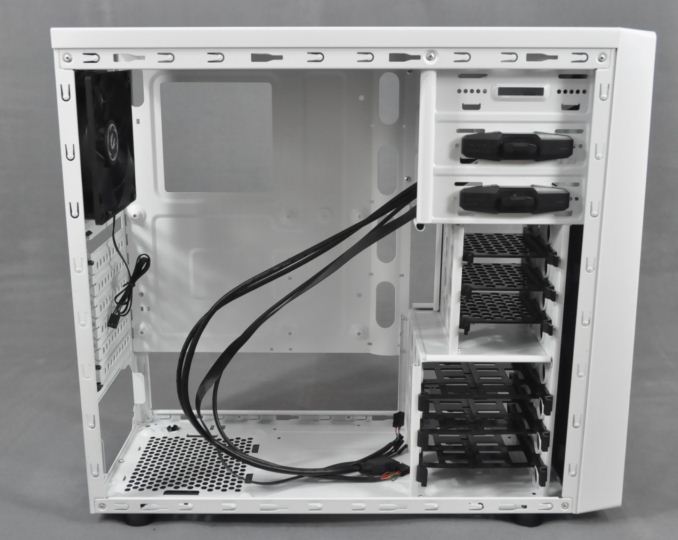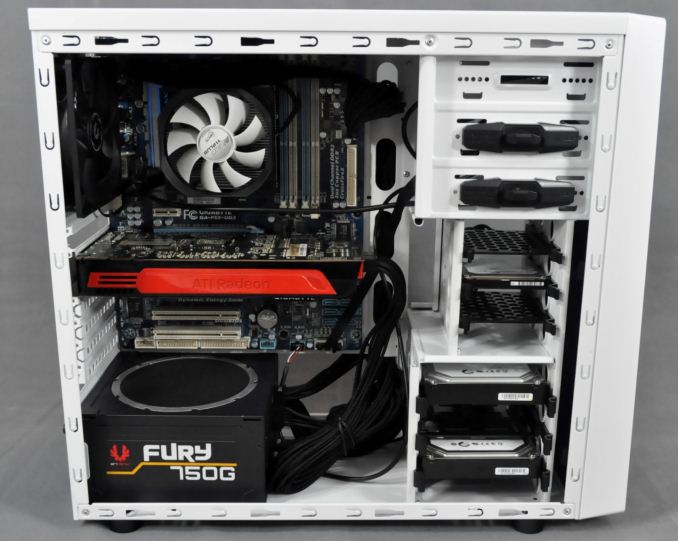BitFenix Neos Case Review
by E. Fylladitakis on January 21, 2015 9:00 AM EST- Posted in
- Cases/Cooling/PSUs
- bitfenix
- Case
BitFenix Neos Interior
The interior of the BitFenix Neos is relatively simple, nearly as much as a generic low cost Mid-Tower case. Everything inside the case is bolted together – no bays or metallic parts are removable. The motherboard tray is sizable enough for a typical ATX motherboard, with an opening behind the CPU area for the installation of CPU coolers.
Of course the size and location won't work for anyone with a motherboard that does not have its CPU socket right at the center of the upper left square area formed by the four screws, which will affect more than half of the motherboards available today, forcing the users to remove them in order to change the CPU cooler. On the other hand, those who rarely change out CPU coolers will be able to install the cooler before installing the motherboard. Note that the case is narrow as well, and CPU coolers taller than 150-155mm are not going to fit. Furthermore, instead of using brass motherboard stand-offs, the tray itself is embossed to form screw fixings for the motherboard. This can make assembly more convenient at times at the cost of some flexibility.
Across the right edge of the motherboard tray, there are four holes for the routing of cables. A fifth hole is present at the top left corner of the tray as well. None of these holes have any rubber grommets and all of them are barely large enough for an ATX 24-pin connector to fit. As there is virtually no clearance behind the motherboard tray for the routing of cables, the right section is elevated for the thick ATX cable to fit. Unfortunately, the use of a couple of PCI Express cables and SATA cables will require more than a little force to close the side panel.
There are three drive cages in the Neos. The top cage is for two 5.25" devices, which can be secured using the plastic locks. The middle cage is narrow, slightly increasing the clearance for one GPU card up to 310mm, and holds three trays for 2.5" devices. Finally, the bottom cage is for three 3.5" devices, but its trays can be used for 2.5" devices as well. For 3.5" devices, no tools are required, but in either case a screwdriver is necessary for the installation of a 2.5" drive.
The motherboard expansion slots are perhaps the greatest issue of the Neos. We have not seen the use of perforated non-reusable covers in a long time, but here they are, the removal of which is permanent and frequently leaves nasty dents behind. Above the expansion slots, the only stock fan of the case can be seen, a black 120mm fan. Take note that due to the narrowness of the case, there is no clearance to install a liquid cooling radiator wider than the fan itself here.
There is plenty of room for any kind of power supply, yet we advise against the installation of a unit longer than 160mm, as the fan opening is small and the displacement of the fan backwards will result in partial blockage, which is a problem with PSUs as it can leave critical components without sufficient cooling. The PSU sits on embossed metallic feet formed from the case panel itself. For this review, BitFenix supplied us one of their Fury 750G PSUs that has individually sleeved cables and is a perfect fit for the Neos.
As exhibited in the pictures of our test build, the interior of the BitFenix Neos is relatively comfortable to work with but can easily end up looking messy, as the cable management options are very limited. The only pathway for the routing of cables, to the right of the motherboard tray, becomes congested with just the thick 24-pin ATX cable going through it. The placement of the hole at the top left corner of the tray appears to have been done with little thought, as a typical motherboard blocks it entirely, leaving no room for a CPU power cable to fit through. There is enough space to comfortably work with the connectors and cables of the 2.5" and 3.5" drives though.
To summarize the component limitations once again, CPU coolers taller than 150mm are not recommended and a single 310mm GPU card may be installed. 160mm long PSUs are strongly advised. The radiators of AIO liquid cooling systems cannot be installed anywhere as well, and the routing options for cables are lacking. Given the price, these flaws could be overlooked provided the performance and other features prove desirable, so let's move on to our testing.


















54 Comments
View All Comments
maecenas - Wednesday, January 21, 2015 - link
Wow, probably the most searing Anandtech review I've seen. Thank you for your honesty, I'll steer clear of this product....nathanddrews - Wednesday, January 21, 2015 - link
The first thing I thought was "are you sure your components are operating properly?" The results are outstanding, for sure. My personal experience with cases has been to either buy the most basic, affordable POS with its own PSU or go big and spend extra to get something really nice. There's not much in between.sfuzzz - Wednesday, January 21, 2015 - link
Well, it's not completely true. For example, The CM N200 is a good microATX case (decent aestetics too, however it's subjective) that costs half the case in this review and can handle pretty powerful systems on air and liquid.drainplugofideas - Wednesday, January 21, 2015 - link
I have that case! I really like it overall.Samus - Wednesday, January 21, 2015 - link
I tried a Bitfenix Prodigy ITX about a year ago, and the case was simply awful. It weighed a ton, the panels were unnecessarily heavy, which directly correlated to poor thermals. It was like an oven inside, even with a 200mm intake and 120mm exhaust fan. The memory modules were too hot to touch. The 200mm fan was useless...even after replacing it with a coolermaster fan, it was apparent the problem was the air holes for the fan. There were 6 of them, and they are dime-sized. The intake system was starved. The appearance of these cases leads you to believe they are well designed, when in fact they are just a crap covered in glitter. The icing on the cake is the price. They are twice as expensive as competing models from Coolermaster, Antec, and Corsair, companies vastly more experienced in case manufacturing and design.Stay away from Bitfenix. If you're going to spend this level of money on something, get a "real" case from Lian Li, Silverstone, or a high end product from another established manufacture.
Gigaplex - Wednesday, January 21, 2015 - link
"I tried a Bitfenix Prodigy ITX about a year ago, and the case was simply awful. It weighed a ton, the panels were unnecessarily heavy"I have a Prodigy, and I agree, it's heavy for its size.
"which directly correlated to poor thermals"
It sounds like you got a model with the solid faceplate. The mesh faceplate models give excellent thermal performance, and I have no issues with mine. Even the AnandTech review of it gave it an Editors Choice award. The fact that the panels are heavy don't contribute to poor thermal performance.
Alexvrb - Thursday, January 22, 2015 - link
While not as good at conducting heat as aluminum, steel isn't really an insulator so I doubt having a little thicker panels is going to trash cooling performance. I've used some really stout cases, including oldschool Lian Li cases that were built out of what seemed like 1/4" thick steel. They worked great even though they had panels that were "unnecessarily heavy". Airflow is much more important and it sounds like the particular model you bought suffered from poor airflow. Based on what I've seen and heard it would Bitfenix has at least some good models out there. Also Coolermaster makes a variety of fans and depending on the model it may not push significantly more air especially in a restrictive case (perhaps due to poor static pressure - if they don't publish this number it probably isn't very good).SleepModezZ - Wednesday, January 21, 2015 - link
Currently on Amazon the N200 is around $50 - as is the cheapest Neos. So not half the price. In Finland where I shop the N200 will cost a bit more than the Neos. Seems like a nice case and better for a gaming system but it is for a microATX board unlike the Neos that takes a full size ATX board. The Neos also has place for two 5.25 drives and not just one. (I don't think that many needs two optical drives but the 5.25 place could be used for something else. I usually have my 3.5 HDDs put into the 5.25 places to eliminate the amplification of vibration and seek noises by the case.)Samus - Wednesday, January 21, 2015 - link
There is no debate about it. Bitfenix makes crap. Anybody who says otherwise either hasn't touched one of their piece of crap products, or unfortunately owns one and is in the deeper stages of denial but will eventually reach acceptance that they do in fact own a piece of crap.There are various Corsair and Coolermaster cases that may not be that much cheaper ($30-$40 such as the Elite 110, Elite 361 and the Corsair Carbide Spec-01) and not much of a looker, but are significantly better at actual cooling.
I've had Rosewill cases that cost $20 and actually work, in that they house and cool components properly. Bitfenix is basically picking up old SECC tooling equipment on the cheap, hiring flunkie engineers to design what looks good, and selling them for bottom-dollar prices based on looks, not functionality or performance.
hughlle - Wednesday, January 21, 2015 - link
Unfortunately your opinion is completely and utterly contradicted by almost every review on the internet. So clearly there is a debate about it.